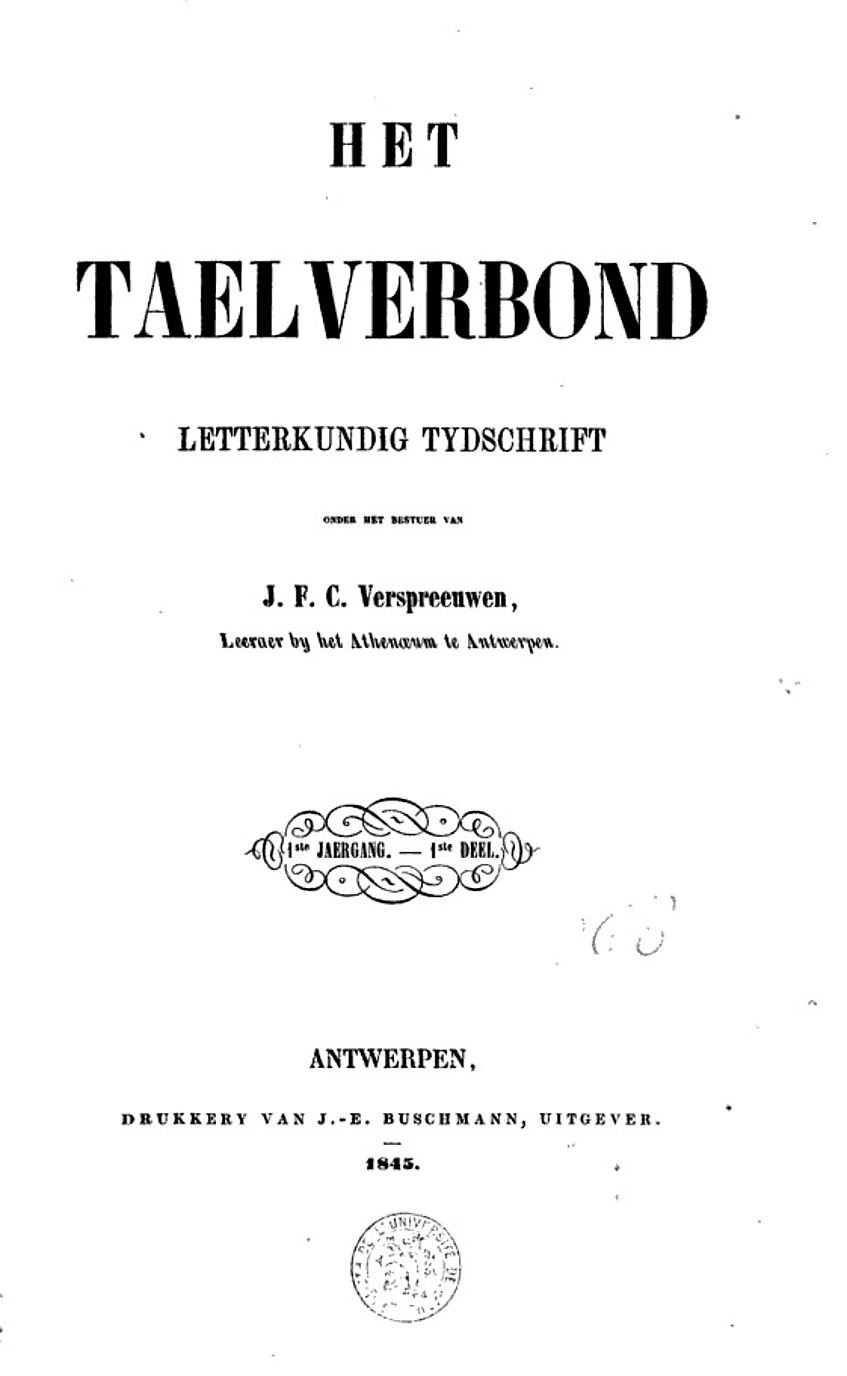Reception
Title page of the first issue of De Broederhand (1845)
Title page of the first issue of Het Taelverbond (1845)
Reception
The critical reception of Flämisches Stillleben has not been as positive or extensive as one would expect from a book that sold 14.000 copies within the first year of its publication (Van Uffelen 47-49). Reviews of Von Diepenbrock’s translation appeared in the Allgemeine Zeitung (1845), in De Broederhand (1845), a Dutch-language journal for “neder- en hoogduitsche letterkunde” edited by Johann Wilhelm Wolf, and in Blätter für literarische Unterhaltung (1846).
Both the critics of De Broederhand and Blätter für literarische Unterhaltung (1846) expressed their disappointment about the fact that Conscience was introduced to the German-language audience by “drei kleinen Novellen” and not by his historical novel De leeuw van Vlaenderen. As the critic of Blätter für literarische Unterhaltung presumes, the “fast allzu große Einfachkeit” of these stories would harm rather than improve Conscience’s reputation (“Flämisches Stillleben in Drei Kleinen Erzählungen von Heinrich Conscience” 3). Written for an audience “welches von dem deutschen himmelweit verschieden ist, welches noch in den ersten Anfängen der Bildung steht” (ibid.), the leading literary magazine mainly recommends Flämisches Stillleben to young readers.
Despite these remarks, the ‘three small novellas’ were praised by both De Broederhand and Blätter für literarische Unterhaltung for their picturesque representation of Flemish life, which was seen as an important contribution to the German knowledge of Flemish culture. In the Allgemeine Zeitung, Gustav Höfken foregrounded the similarities he noticed between Flemish and (Lower) German culture, noting that “zwischen allen niederdeutschen Landen in der Tiefe ein geistiger Zusammenhang fortbesteht“ (Höfken 988).* Coming from the same region as the translator, the language of Von Diepenbrock as well as several cultural references in Flämisches Stillleben reminded Höfken of his own childhood in Westphalia. He sees another cultural similarity in “das Verwälschen” (the “Frenchification”, ibid.), which according to him threatens in particular the higher classes in Germany. Conscience’s aversion to this “Entartung” (ibid.) makes these stories all the more instructive to the German audience, Höfken writes.
Höfken, who quotes Von Diepenbrock’s preface extensively in his article, is not the only critic to point out Conscience’s luck to have the Prince-Bishop of Breslau as his promotor and translator, introducing him “an fester treuer Hand” (ibid.) to the world of German literature. Despite Von Diepenbrock’s honorable reputation, the reactions to his skills as a translator are mixed. Whereas Höfken values Von Diepenbrock’s translation for staying close to the Dutch language and expressions, in De Broederhand, J.F. (presumably a pseudonym of the Germanist J.W. Wolf, see Deprez and Vanacker 13) criticizes several translation choices as well as Von Diepenbrock’s style and grammar.
That it was a German bishop who translated Conscience’s works did not go unnoticed in Flemish literary circles. In 1845, the literary magazine Het Taelverbond published a biographical sketch of Von Diepenbrock. In the first sentences of the article, his Conscience translations are referred to as a proof of his affection for “onze vaderlandsche letterkunde” (“Vryheer Melchior von Diepenbrock” 117). The biographical sketch, based on a text from the Schlesische Kirchenblatt, contains some translated excerpts of Von Diepenbrock’s sermons as well. In later issues, the Antwerp magazine, issued by the same publisher as Conscience’s Antwerp novellas, kept its readers updated on further editions of Flämisches Stillleben. In 1849, Het Taelverbond announced the third edition of Flämisches Stillleben (Regensburg 1849). The same year, the first three editions of Flämisches Stillleben appeared on a list of Conscience translations in various languages, which could be ordered at the Kornicker book store in Antwerp (“Kunst- En Letternieuws” 570–71).
Apart from the contributions in De Broederhand and Het Taelverbond, however, Flämisches Stillleben did not receive much attention in the Dutch-language area. An interesting exception is the second edition of the Geschiedenis der Nederlandsche letteren: een handboek voor gymnasiën en hoogere burgerscholen (Amsterdam 1873) by W. Everts. Everts was the director of the catholic school community at Rolduc. He mainly refers to Von Diepenbrock’s translation to describe Conscience’s oeuvre: “De Antwerpenaar Hendrik Conscience (geb. 1812) heeft het “Flämische Stilleben [sic]” – gelijk de Hoogduitsche vertaler van eenige zijner romans, de overleden Aartsbisschop van Breslau, Melchior von Diepenbrock, het noemt – met treffende waarheid, roerende innigheid en onnavolgbare naïeviteit geschilderd” (Everts 292).
* We wish to thank Jasmin Streunding (Eastbound) for supplementing the collection of German-language reception documents on Conscience and other authors in the DLBT.
Select Bibliography
Everts, W. Geschiedenis der Nederlandsche letteren: een handboek voor gymnasiën en hoogere burgerscholen. 2nd ed., Van Langenhuysen, 1873.
“Flämisches Stillleben in Drei Kleinen Erzählungen von Heinrich Conscience.” Blätter Für Literarische Unterhaltung, Jahrgang 1846. Erster Band. Januar Bis Juni., Brockhaus, 1846, pp. 3–4.
Höfken, Gustaf. “Zur Flamändischen Litteratur. Flämisches Stillleben in Drei Kleinen Erzählungen von Heinrich Conscience. Aus Dem Flämischen Übersetzt von Melchior von Diepenbrock. Mit Holzschnitten.” Allgemeine Zeitung, 4 Apr. 1845, pp. 987–88.
J.F. “Flämisches Stilleben in Drei Kleinen Erzählungen von Heinrich Conscience.” De Broederhand, July 1845, pp. 20–22.
“Kunst- en letternieuws.” Het Taelverbond. Letterkundig Tydschrift, vol. 5, no. 6, 1849, pp. 569–73.
"Kunst- en letternieuws". Het Taelverbond. Letterkundig Tydschrift, vol. 5, no. 6, 1849, pp. 187–92.
Van Uffelen, Herbert. Moderne niederländische Literatur im deutschen Sprachraum 1830-1990. Zentrum für Niederlande-Studien, 1993.
“Vryheer Melchior von Diepenbrock.” Het Taelverbond. Letterkundig Tydschrift, vol. 1, no. 1, 1845, pp. 117–21.


